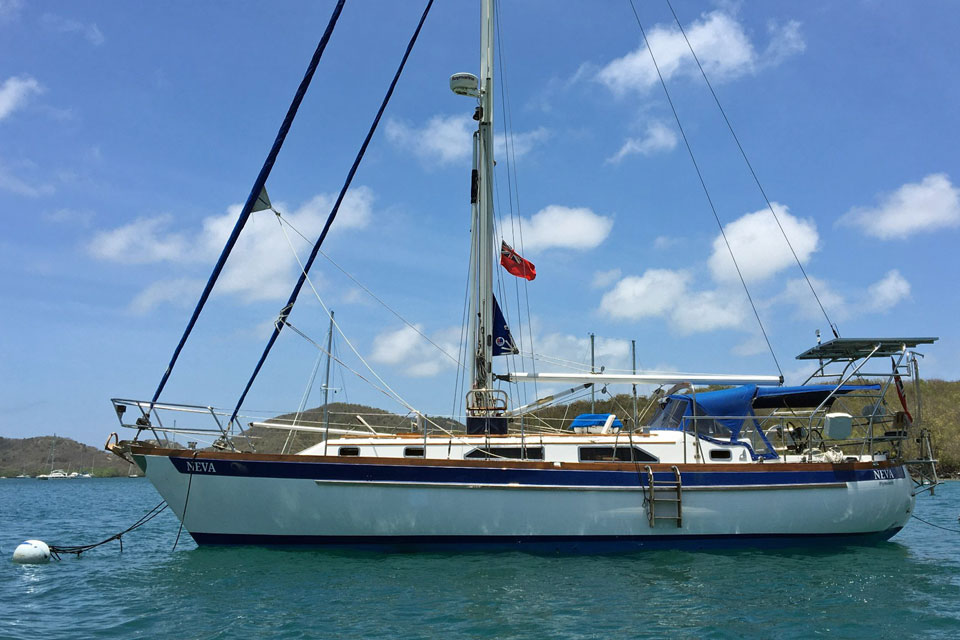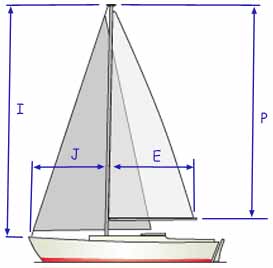- Home
- Cruising Yachts 40' to 45'
- Slocum 43 Specs
The Slocum 43
Specs & Key Performance Indicators
The Slocum 43 sailboat, designed by Canadian naval architect Stan Huntingford, is a cutter-rigged vessel known for its robust construction and seaworthiness. It was built by Formosa Boat Building Co Ltd in Taiwan from 1981 to 1990.
 The Slocum 43 cutter
The Slocum 43 cutterPublished Specification for the Slocum 43
Keel & Rudder Configuration: Fin keel with skeg-hung rudder
Hull Material: Fiberglass (GRP)
Length Overall: 42'6" (12.9m)
Waterline Length: 35'10" (10.9m)
Beam: 12'11" (3.9m)
Draft: 6'4" (1.9m)
Rig Type: Cutter
Displacement: 28,104 lbs (12,748 kg)
Ballast: 9,000 lbs (4,082 kg)
Water Tank Capacity: 150 gallons (568 litres)
Fuel Tank Capacity: 120 gallons (454 litres)
Hull Speed: 8.02 knots
Designer: Stan Huntingford
Builder: Formosa Boat Building Co Ltd.
Year First Built: 1981
Year Last Built: 1990
Number Built: 60
Options & Alternatives
- Pilothouse Version: This version featured an enclosed steering station, providing better protection from the elements compared to the original open cockpit design.
- Passport 42: Although not a direct successor, the Passport 42 was based on the same design as the Slocum 43. It offered similar characteristics but was marketed under a different name.
Sail Areas & Rig Dimensions
- Mainsail Area: 338ft² (31.4m²)
- Foresail Area: 471ft² (43.8m²)
- Total Sail Area: 809ft² (75.2m²)
- I: 53'0" (16.15m)
- J: 18'0" (5.49m)
- P: 47'0" (14.33m)
- E: 15'0" (4.57m)
Published Design Ratios
The Key Performance Indicators (KPIs)
- Sail Area to Displacement Ratio (SA/D): 14.0
- Ballast to Displacement Ratio (B/D): 32.0%
- Displacement to Length Ratio (D/L): 272.8
- Comfort Ratio: 37.7
- Capsize Screening Formula: 1.70
These Design Ratios can be analysed collectively to predict the theoretical sailing characteristics of the Slocum 43:
- The Sail Area to Displacement Ratio of 14.0 indicates that the Slocum 43 is somewhat underpowered. It suggests that the boat may not have exceptional performance capabilities, particularly in lighter winds, but it can still perform adequately for cruising purposes.
- With a Ballast to Displacement Ratio of 32.0%, the Slocum 43 shows a moderate level of stiffness. This means while it will not be as resistant to heeling as stiffer boats with a higher ratio (40% or more), it should still stand up to wind reasonably well, making it a balanced cruiser.
- The Displacement to Length Ratio of 272.8 places the Slocum 43 in the upper end of the moderate displacement category (200-275). This suggests that the boat strikes a good balance between being driven easily by its sail area and having some heft for stability and comfort.
- A Comfort Ratio of 37.7 indicates that the Slocum 43 has reasonably sedate motion, characteristic of a moderate bluewater cruising boat. This means it should handle offshore conditions reasonably well, providing a comfortable ride with less pronounced pitching and rolling compared to lighter boats.
- With a Capsize Screening value of 1.70, the Slocum 43 is considered suitable for bluewater sailing. Values below 2.0 indicate a lower risk of capsize in rough ocean conditions, making this boat appropriate for longer ocean passages.
In summary, the Slocum 43 is designed as a moderate bluewater cruiser with adequate performance. It has a reasonable degree of stiffness and comfort, making it well-suited for offshore sailing with good seakeeping abilities. Its moderate displacement and bluewater capability ratios ensure it is capable of handling various sea conditions while providing a stable and comfortable sailing experience.
Here's how to calculate the KPIs yourself - without having to wrestle with the mathematics...
Design Ratios: Notes of Caution...
- The Sail Area/Displacement Ratio (SA/D): This ratio provides an estimate of the sail power relative to the boat's weight, which can indicate potential speed in various wind conditions. But it doesn't account for the efficiency of the sail plan, the rigging, or the skill of the crew. Real-world performance can vary significantly based on these factors.
- The Ballast/Displacement Ratio (B/D): This ratio gives an idea of the boat's stability and stiffness, which is crucial for handling and safety. But it doesn't consider the distribution of the ballast or the hull shape, both of which can greatly affect stability. A high B/D ratio alone doesn't guarantee a stable boat if the ballast is poorly distributed.
- The Displacement/Length Ratio (D/L): This ratio helps predict the boat's speed potential and its behaviour in different sea conditions. But it doesn't account for the hull design or the boat's overall weight distribution. Two boats with the same D/L ratio can perform very differently if their hull shapes are different.
- The Comfort Ratio (CR): This ratio estimates the boat's motion comfort in a seaway, which is important for long passages. But it doesn't consider the boat's interior layout, which can also affect comfort. Additionally, personal tolerance to motion varies, so a boat that is comfortable for one person might not be for another.
- The Capsize Screening Formula (CSF): This formula assesses the likelihood of a boat capsizing in heavy seas, which is critical for offshore safety. But it doesn't take into account the boat's handling characteristics or the skill of the crew. A boat with a low CSF can still capsize if poorly handled in severe conditions.
General Limitations
- Static Nature: These ratios are static measurements and don't account for dynamic factors like wave action, wind gusts, or crew actions.
- Simplification: They simplify complex interactions into single numbers, which can be misleading. Real-world performance is influenced by a multitude of factors that these ratios can't fully capture.
- Context: The context in which the boat is used (e.g., coastal cruising vs. offshore racing) can greatly affect how these ratios should be interpreted.
In summary, while these ratios provide valuable insights into the theoretical performance characteristics of a sailboat, they should be used as part of a broader assessment that includes practical experience, sea trials, and expert advice.
This article was written with the assistance of Gemini, a large language model developed by Google. Gemini was used to gather information, summarize research findings, and provide suggestions for the content and structure of the article.
Recent Articles
-
Is Marine SSB Still Used?
Apr 15, 25 02:05 PM
You'll find the answer to this and other marine SSB-related questions right here... -
Is An SSB Marine Radio Installation Worth Having on Your Sailboat?
Apr 14, 25 02:31 PM
SSB marine radio is expensive to buy and install, but remains the bluewater sailors' favourite means of long-range communication, and here's why -
Correct VHF Radio Procedure: Your Questions Answered
Apr 14, 25 08:37 AM
Got a question about correct VHF radio procedure? Odds are you'll find your answer here...













